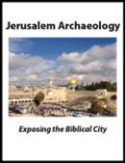
The Atlantic pistachio tree (Pistacia atlantica) produces resin that is the best candidate for the balm of Gilead in the Bible. Photo: Courtesy Zohar Amar.
The Bible describes a “balm” of Gilead that is counted among “the choice fruits of the land” (Genesis 43:11). Renowned for its medicinal and aromatic properties, it was a prized product in ancient times—and today.
In the Summer 2023 issue of Biblical Archaeology Review, Zohar Amar of Bar-Ilan University identifies the biblical balm with the resin of a real plant in his article, “Balm of Gilead.” After surveying the balm’s appearances in the Bible and ancient texts, he identifies the best candidate for the balm of Gilead and even reconstructs the extraction process. For step-by-step photos of this process, see www.biblicalarchaeology.org/balm.
Beginning with the biblical text, Amar shows that there is a “balm” (Hebrew: zori) associated with the region of Gilead, located northeast of the Sea of Galilee in modern Jordan. The balm of Gilead appears in six biblical texts: Genesis 37:25; Genesis 43:11; Jeremiah 8:22; Jeremiah 46:11; Jeremiah 51:8; and Ezekiel 27:17. The verses from the Book of Jeremiah emphasize the balm’s medicinal benefits. The other verses list the balm among valued products of the land, including oil, honey, gum, and resin.
In addition to the Bible, the balm of Gilead appears in Egyptian, Greek, Roman, and Arabic texts. Amar explores some of these texts in his article. Notably, in the 14th century BCE, the queen of Ugarit (on the coast of northern Syria) sent a jar of zori, along with a letter, to the queen of Egypt. Later Sabaic inscriptions from southern Arabia (modern Yemen) name the balm as an important type of incense; Amar explains that in those, the balm of Gilead is preserved by the ancient Arabic name darw. The Greek physician Dioscorides (d. 90 CE) also expounded on the balm’s benefits.

Amar concludes that the resin of the Atlantic pistachio tree (Pistacia atlantica) is the best candidate for the balm of Gilead. This tree still grows in the arid regions of the biblical lands, including Gilead, and its resin is harvested in countries such as Jordan, Iraq, and the United Arab Emirates.

The balm of Gilead in the Bible is renowned as a medicinal and aromatic product, and it may be equated with the resin from the Atlantic pistachio tree. Here, resin from the Atlantic pistachio tree gathers in a clay pot that has been attached to the trunk. Photo: Courtesy Zohar Amar.
Amar and his student Elron Zabatani conducted an experimental archaeology project wherein they extracted resin from 80 Atlantic pistachio trees throughout Israel. They discovered that the trees produce large quantities of resin, with the average tree producing about 0.7 pounds of resin per season and large trees producing about 1 pound of resin. This high yield is more than any other tree in Israel.
After collecting the resin, it is boiled and then mixed with wax. The balm is consumed and applied topically for various health benefits. Amar lists some of its benefits: “It is used for various medicinal purposes, such as relieving throat infections, lowering cholesterol, treating stomach ulcers, alleviating stress, and more.”
Amar reports that the local inhabitants of Gilead no longer harvest the balm from Atlantic pistachio trees. The trees stopped producing resin about 20 years ago. Nevertheless, for those so inclined, you can still acquire some of the biblical balm—albeit no longer from Gilead. To learn more, see Zohar Amar’s article, “Balm of Gilead,” published in the Summer 2023 issue of Biblical Archaeology Review.
Read more in Bible History Daily:
Not a BAS Library or All-Access Member yet? Join today.
The post Searching for the Balm of Gilead first appeared on Biblical Archaeology Society.
The post Searching for the Balm of Gilead appeared first on Biblical Archaeology Society.


0 Commentaires